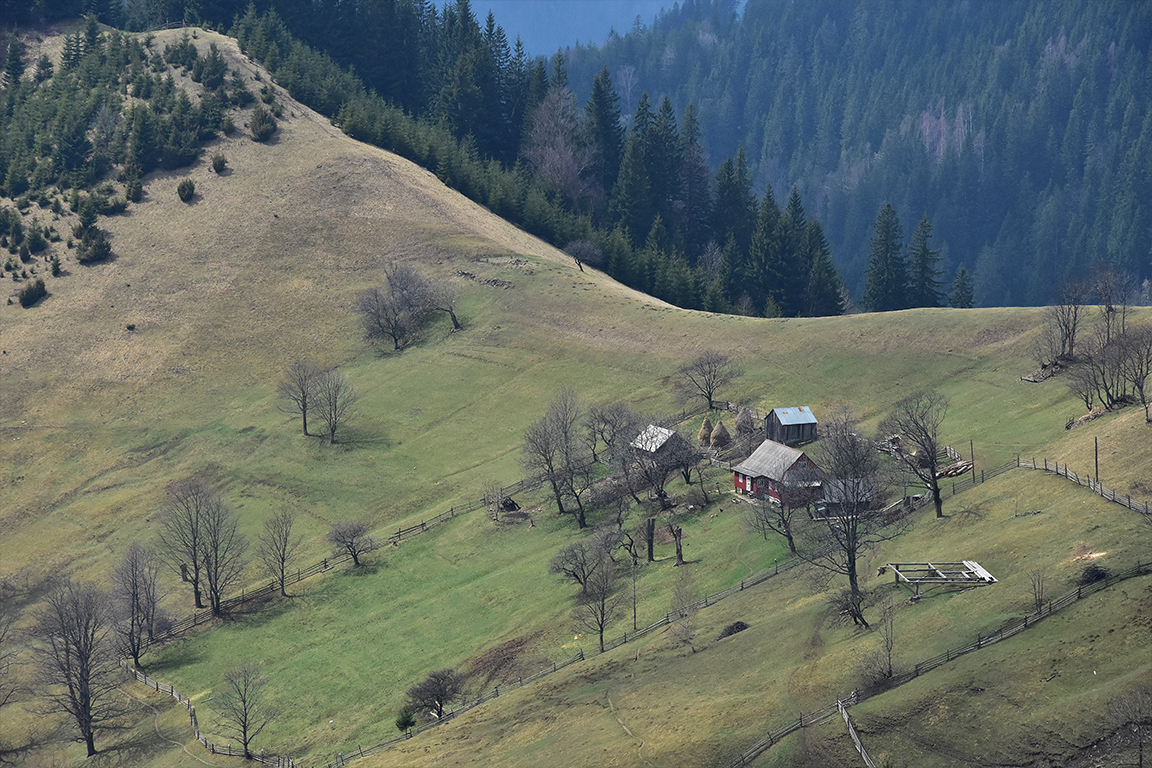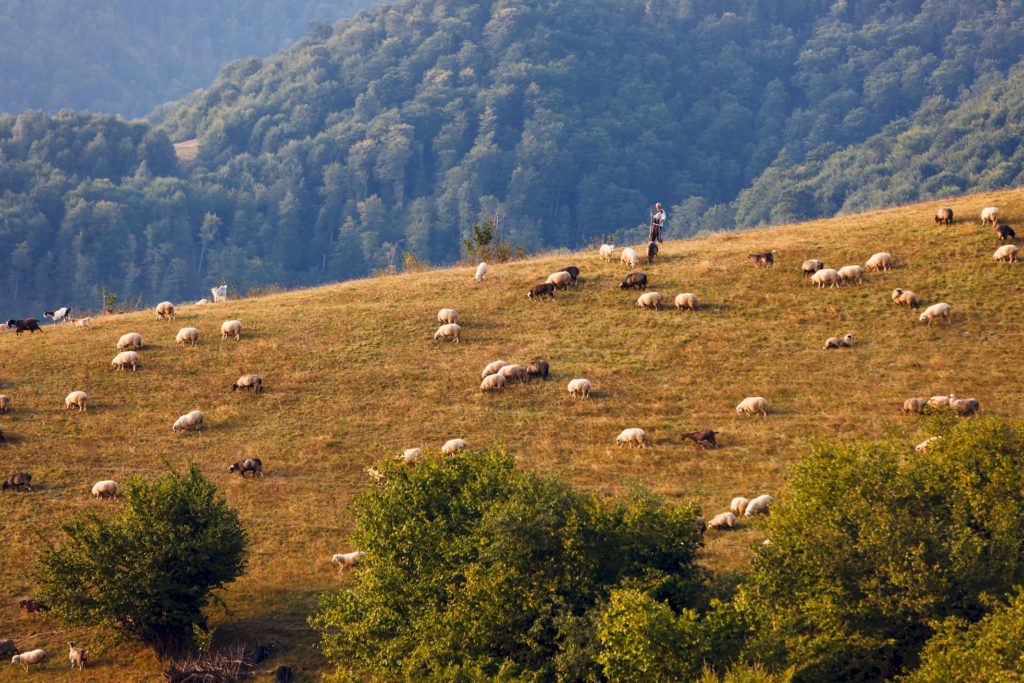Hustuls (Ukr. Гуцули, Ro. Huțuli) is an ethnic group of highlanders living in part of the Eastern Carpathians – Gorgany, Chornohora, Svydovets, Marmorian Carpathians, Połoniny Hryniawskie and Beskidy Pokucko-Bukowińskie. They have Ruthenian and Wallachian origins, which influenced the general character of these lands in history.
They were engaged in cattle breeding and livestock breeding, hunting and trading on a daily basis, but it was shepherding that became their domain. Oskar Kolberg, an outstanding Polish folklore expert and ethnographer, in one of his volumes “Dzieła Wszystkie” reserved for “Ruś Karpacka” (Volume 54), attempted to determine the area in which the Hutsul shepherds’ houses were closed. It was Pokucie (Pokuttya), Bukovina, parts of adjacent Hungary, the former county of Stryi along the north-western border of Hungary, to the villages of Majdan and Rosulna, further turning east and south, reaching the former counties of Stanisławów and Kolomyja, going further to the north, next to the cities of Solotvyn , Nadvirna, Deliatyn, Pistyń, Kosovo and Kuty, then crossing the Bucovina border around Watra -Moldawitz and to Carlibaba. It is worth noting that Kolberg used geopolitical nomenclature at the end of the 19th century, which is now a kind of history trivia. It is also worth noting that the areas occupied by the Hutsuls also received a name referring to the term of the people living there, so in the literature there is still a following name: Huculszczyzna (Hustul region).
One of the most outstanding researchers of the Hutsul region, Włodzimierz Szuchiewicz, wrote about Hutsuls as follows: Ten Hucuł (This Hutsul). For whom the horse and shotgun were until recently unavailable companions, this Hutsul, who with the sound of his trembita welcomes the rising sun on the pastureland and says goodbye to his companion laid to his grave – will soon become a mythical figure. Furthermore, Oskar Kolberg added a few words: Hutsuls believe in ghosts and they are afraid of ghosts. In the mountains, the old people deal with afterlife world, they know the future, they foresee from the palm of their hands, from a bird’s eye view, from the entrails of cattle. From the above quotations, we see a mysterious people, indeed almost “mythical” as Włodzimierz Szuchiewicz described them, surely stuck firmly to their own tradition and culture, which drew a handful from the geographical conditions, which in turn determined the daily behaviour of the people living in the area. Based on these two laconic quotations, which are at the same time precise in their description, we can understand that we are talking about shepherds whose profession has absorbed their entire life and their approach to it. The everyday life of the Hutsuls is observed in their folklore, in a wide range of this area of life, such as fairy tales and legends originating from that region, folk songs and adages, that are still in use today. We know that the “literary” work of the Hutsul folklore is very extensive, full of local, but also universal motifs, which can be seen in other regions of the European continent or moving around the micro-region, in the Carpathians.
Shepherd’ s role in the past times
The beginnings of shepherding among the Hutsuls date back to the 14th and 15th centuries, when part of the Eastern Carpathians was subject to the Wallachian colonisation. What is left of the Wallachians and their profession is a name derived from the Romanian language, as well as from the traditions typical for the shepherds. It is worth adding that in these conditions the Wallachian population assimilated with the encountered Russian population, from which the Hutsul shepherds originated. They settled in high mountain areas and moved from nomadic life to the settled one. Undoubtedly, this was influenced by natural conditions, i.e. vast mountain meadows, clearings located among forests and meadows rich in forage. The Hutsuls grazed various kinds of cattle, especially goats, sheep, horses, cows and oxen. The entire grazing cycle was determined by weather conditions. The beginning of grazing, or rather the appearance of animals on the slopes, fell on 6th May, on the Saint George day, counting according to the liturgical calendar of the Greek Catholic Church. At that time there was less snow on the mountain meadows, and the slopes were exposed and well sunny. In turn, on 22nd May, that is on Saint Nicholas day, shepherding was officially started, which were solemnly celebrated throughout the turn of May and June. Related to this are the following motifs ofPolonynachid and podaj na mir. The final moment of the shepherding time was also regulated by some sort of beliefs that were the source of orders. Having cleaned the shepherd’s place, people were waiting for the fire to become faded, in the so-called staja (a shelter). Fire extinguishing was prohibited. The Hutsuls believed that shepherds who would extinguish the fire must die soon. It was forbidden to enter the shelter or the kolyma (camp) for several days after the fire has been extinguished. The shelter was occupied by a demon called mara, who was its supervisor. It was to be the spirit of a man who died too soon. The end of shepherding time usually fell on the Our Lady of the Herbs – Assumption of Mary, so on 28th August. The richest shepherds among the Hutsuls were referred to as gazda. This is an analogy even to the highlanders of Podhale, where this term also appeared. The seasonal shepherd farm in the mountain meadow belonged to the deputy, who in turn employed a head shepherd, i.e. a Hutsul robber band. The very announcement of the beginning of shepherding was referred to as wesnowanie. Young boys who were helping at the mountain meadows were so-called honinnycy. The particular shepherds taking care of individual animals had their own names: wiwczar was a sheep shepherd, jałoczar took care of rams and infertile sheep, in turn korowar or hajdej shepherded horned cattle, and bowharz was a supervisor of oxen, stador took care of horses, and kozara dealt with goats. Profits that were obtained from pastoral life were mainly wild game, dairy and meat products, leather as well as leather and linen products. At the end of the season, the time to come home started, the time to prepare the products and then to sell them in local villages as well as in the bigger city centres. Above all, preparations have been made for the next shepherd season.
Hutsul as a modern shepherd
In the Hutsul region, despite the post-war changes in ownership and current economic transformations, the traditional mountain pastoralism has been preserved. Currently, there are about 40 seasonal shepherding farms in Chornohora, for example, which try to cultivate the tradition of their fathers. The largest number of them occurs in the western part of these mountains, namely in the massif of Pietros and Szeszuł. Shepherding is carried out there by the inhabitants of neighbouring villages, such as Kwasów, Roztok and Bogdana. In eastern Chornohora, the shepherds from Babi near Kosiv and Rakhiv graze the flocks. Have we already encountered these names? Yes, we have! At the end of the nineteenth century, Oskar Kolberg mentioned them in detail, he followed the issue of the distribution of the Hutsul region on the map of
the Eastern Carpathians.
Coming back to present times and the topic of pastoralism – this profession is nowadays continued. Obviously, it is not so popular as it used to be in the pre-war period, although it is characteristic for this region. We can also take a closer look at it, at the contemporary festivals and rallies, whose main purpose is to present the colour of the Eastern Carpathians and the Hutsul region culture. Such and similar festivals take place even in Poland, mainly in the Bieszczady Mountains and the Beskid Mountains, the areas where a similar tradition has taken place and still it is cultivated. These are also Polish regions, which are culturally and linguistically similar to the Eastern Carpathians. There is also the term połonina (mountain meadow), wadra and sioło, which is the equivalent of Wallachian and Russian staji (shelter). Let us also look at local folklore, especially the most archaic forms that give us an idea that mountains are just a metaphor, a border that is just a name. The invasion of motifs, behaviours and, above all, people, was not a problem. What is more, the mountain meadows located very high were the impulse of the exchanges of tradition, culture, language and opinions. Shepherding in this sense was a method of entrance, despite the difficult mountain conditions.




















